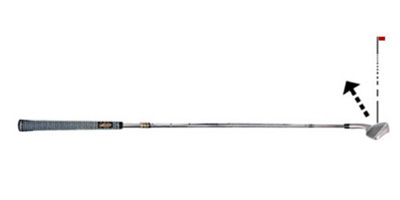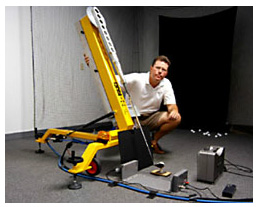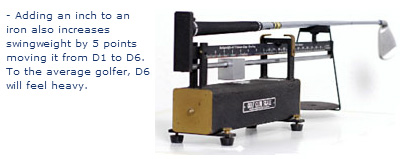Whether you are custom building a set of irons or adding a scoring wedge to your set, club length and club lie are important parts of the fitting equation. They can work together to create a club that will help you play better golf and enjoy the game more.
Definition of Lie Angle
First, we will examine the importance and influence of club lie and then turn our attention to club length.

Lie angle is related to the iron's overall length. As irons get longer, designers must decrease or "flatten" the lie angle to make the club perform correctly. Thus, a 9 iron has a higher lie angle or is more "upright" than a 3 iron. It stands to reason, if the iron's length is adjusted in the custom fitting process we should also address the lie angle.
| Previous | Next |
Lie's Affect on Shot Direction
When custom building irons and wedges, club lie is a determining factor for both shot direction and distance. Clubs that are too upright or flat will produce offline shots that will usually fall short of the intended target.

Club length, lie and loft are tied together in a delicate balance. You cannot change one without having an effect on the others. An accurate fitting system will put all of these specifications into the equation to achieve the best possible fit for a player's physical measurements.
| Previous | Next |
How Lie Affects Shot Direction
A club's lie angle determines the directional plane of the clubface. OK, so what does that mean? Try this extreme illustration to demonstrate it for yourself. Take a 9 iron in the normal address position with the face pointing toward a target. Now lower the grip end of the club to the floor.

When laid on the floor, a typical 42 degree 9 iron will have 0 degrees of loft and be closed to the target 48 degrees. If the ball were struck from this stance it would start 48 degrees left of the target with the ball's spin taking it even further left. Lie angles that are less than perfect in longer clubs like drivers and 3 woods will produce less directional error because they have less loft.
| Previous | Next |
GigaGolf Swing Robot
OK, that makes sense but how much difference will two or three degrees make? To answer that question we are going to need the help of GigaGolf swing robot. TO quantify the need for lie adjustments, the GigaGolf swing robot was rigged with a 9 iron and set up to fire 10 shots with the correct lie angle and then another 10 shots with the lie angle 3 degrees too flat.

| Previous | Next |
Results from the Robot

With the correct lie the GigaGolf swing robot was able to hit the target's centerline with ease (Offline = 0.0 +/- 2.2 yards. Carry distance = 140.7 yards +/- 2.4 yards). But when the GigaGolf robot's lie was flattened 3 degrees the shot dispersion was significantly right of the target line (Offline = 8.4 +/- 2.9 yards. Carry distance = 135.4 +/- 5.7). Not only did the robot hit the ball 25 feet right of the target, it also lost 15 feet of distance because the incorrect lie added loft and spin.
| Previous | Next |
Getting eFit
When a player is hitting from the fairway, the directional error is magnified by the clubs contact with the turf. Clubs that are too flat will make contact with the turf toe first which causes the clubface to open and send the ball further right. On the other hand, Clubs that are too upright will make contact heel first which closes the face and sends the ball left.
How do I know I have the correct lie? The best way for most golfers to ensure the lie of their clubs is correct is to use a system that is based on their physical body measurements. The GigaGolf eFit system is based on a perfect setup and swing. Getting your clubs fit in this way will help you grove your swing to the correct plane for your physical stature.

| Previous | Next |
Length Adjustment
The GigaGolf eFit system uses a lie adjustment in combination with a minimal length adjustment to fit a golfer's physical specifications. Club heads are designed at specific weights to obtain optimal balance points (or swingweight) for a given club length. Changing the length of the club affects the swingweight.
- Adding length increases swingweight making the club feel heavy.
- Reducing length decreases swingweight making the club feel lighter.

For example, GigaGolf's 8 irons are designed to be 36.5 inches long. At the length, the swingweight will be close to the industry standard of D1. Adding 1 inch to the club also adds 5 to 6 swingweights. Now the club swings at D7, which is noticeably heavy to the average golfer. Some players like longer heavy clubs but most will hit the ball more consistently with lengths closer to standard.
| Previous | Next |
Dynamic vs. Static Fitting System
Should I get fit by a local clubfitter? Some players that are satisfied with their swings may benefit from a dynamic fitting from your local PGA professional. However, most golfers we know are constantly working on their swings trying to improve and refine their game. Why get your clubs fit to a swing you hope will change for the better? Or maybe your swing is more upright than usual on the day you are fit. Or worse, the clubfitter you visit is not really that good.
The GigaGolf eFit system will help you build clubs that will help you improve your swing, eventually making it more repeatable and reliable. We need two simple measurements that are detailed in the "eFit Lie" section of the club building process to achieve an accurate fitting.
Note: GigaGolf adjusts the lie of your irons and wedges using golf club lie machines that are accurate to the .25 degree. The machines make tiny impressions on the sole and hosel of the clubhead. These small marks to not affect the performance of the club and are the same marks you will find on the clubheads of virtually every professional on the PGA tour.
| Previous | Next |